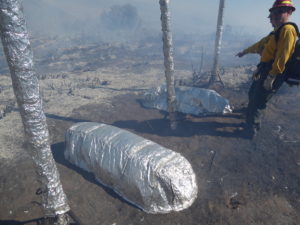NC State rises to the challenge of developing the next generation wildland fire shelter.

The Textile Protection and Comfort Center at North Carolina State University (NC State) has recently completed a project to develop advanced fire blocking materials for wildland fire shelters. Roger Barker, director of the center discussed the three-year-long project at IFAI’s Expo in Dallas last fall.
The standard most recently for fire shelters has been the M2002, Barker said. It’s simple, inexpensive, provides excellent radiant protection, but flame protection has been poor. Generation 1 shelters consisted of a single layer of aluminized fiberglass. Generation 2 versions had an outer layer of the “dome” made of thick, woven aluminized silica, an inner dome layer of thin woven aluminized fiberglass and a bottom or floor of two-sided aluminized silica.
But this construction was not providing enough. “It’s a violent situation in a fire,” Barker said. Strong winds are among the factors that can challenge the effectiveness of the shelter, degrading a shelter’s aluminized layer.
Development strategy
In order to create a shelter that would provide better flame protection, in particular, the team established a four-point strategy intended to produce a successful end product:
1. Understand wildland fire and shelter failures
2. Develop enhanced flame-blocking materials
3. Develop enhanced shelter seam constructions
4. Test shelter thermal protective performance from lab to field.
The shelter itself would have four layers. The outermost layer is for radiant energy—the predominant heat as the fire approaches and leaves. The next layer is a convective blocker designed to block flames and hot gases to prevent burn injuries and to prevent smoke from entering the firefighters “breathing space.” Convection is the predominant danger during a burn-over. The third layer is insulation to minimize conduction between the layers, and the innermost layer is meant to block flames, hot gases and smoke, as well.
The team evaluated more than 250 materials. “Building a good fire blocker is not easy. It’s not just about heat resistant material. You have to think about where to position the layers and in what order. This material had to be not too much weight and had to be packable.” Improving seams was also part of the larger picture, since “seams are nothing more than holes,” he said.
Survivability in flames was the key criteria, however, and eventually they had a dozen composite structures to study. To do that, a full-scale test method with specific criteria was established. The team would realistically simulate a wildland forest fire burn-over, study heat flux intensities, as well as what happens in sustained contact with turbulent flames, such as are typical in wind-driven fires. The researchers wanted to reproduce the degradation effects that they’d seen in fire shelters that had been used in actual fires. That would help them establish controlled, reproducible measures for their shelters’ performance that they could correlate with shelter performance in field tests.
The PyrodomeTM in their lab made this possible. “We were able to replicate something close to a wild fire to test it, including up to 65 seconds of direct contact with turbulent flames,” he said. The device was able to measure two key factors: interior air temperature, measured at two inches from the floor; and time to observed failure of the shelter’s heat blocking materials.
“Within about 30 seconds, there was enough heat to penetrate the shelter of the M2002, the old shelter, but one that is currently in use,” he said. “With the new one, the protection time has been extended by two times to more than a minute,” he said.
Into the field
The plan also included field testing in various environments that had differing fuel types, including chaparral in California, grasslands in South Dakota, pine and upland hardwood in North Carolina, and boreal (mature, short needle) forest in Canada.
The extensive field testing confirmed what they’d predicted in lab tests about thermal protective performance, and it also confirmed the turbulent nature of wind-driven flames in burn-overs.
The team ultimately settled on three distinct shelter options that varied according to weight, level of protection, ease of manufacturing, seams, material availability and packaging options. Overall these NC State developed prototypes outperformed the existing M2002, with the heat blocking materials developed exceeding currently used materials technology.
Their work also has a provided a foundation for standards to be developed, which Barker thinks would “raise all the boats,” and he advocates for open-source information. “We’re not the only ones working on better shelters,” he said. [But] right now there is no standard for a shelter,” he said. “I really believe our research is going to be of great value for test methods and creating a standard.”
The U. S. DHS Federal Emergency Management Agency (FEMA) Assistance to Firefighters Grants Fire Prevention and Safety Program provided funding for the project.
Video credit: NC State.
Janet Preus is senior editor of Advanced Textiles Source. She can be reached at jlpreus@ifai.com.
 TEXTILES.ORG
TEXTILES.ORG


